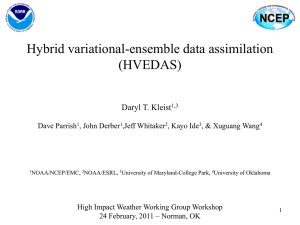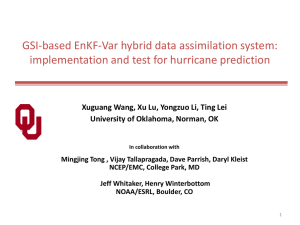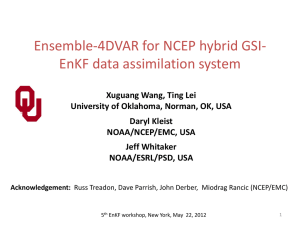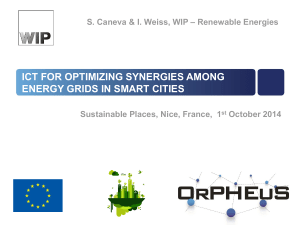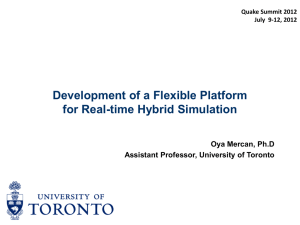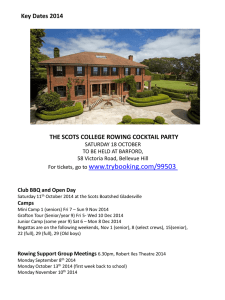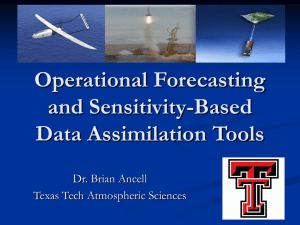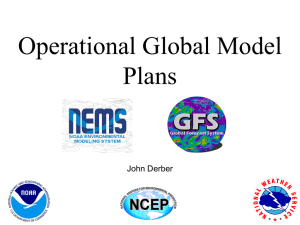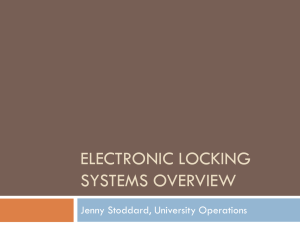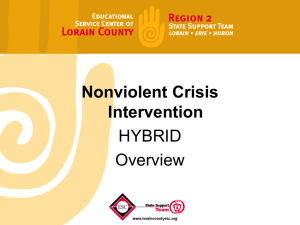Numerical Weather Prediction in the Middle Atmosphere
advertisement
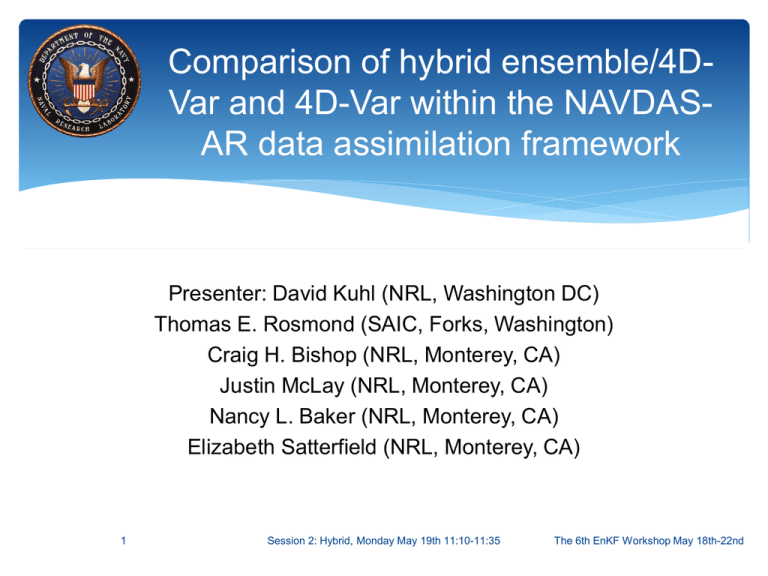
Comparison of hybrid ensemble/4DVar and 4D-Var within the NAVDASAR data assimilation framework Presenter: David Kuhl (NRL, Washington DC) Thomas E. Rosmond (SAIC, Forks, Washington) Craig H. Bishop (NRL, Monterey, CA) Justin McLay (NRL, Monterey, CA) Nancy L. Baker (NRL, Monterey, CA) Elizabeth Satterfield (NRL, Monterey, CA) 1 Session 2: Hybrid, Monday May 19th 11:10-11:35 The 6th EnKF Workshop May 18th-22nd Overview This talk covers the effect on weather forecast performance of incorporating ensemble covariances into the initial covariance model of the 4D-Var DA system NAVDAS-AR (Naval Research Laboratory Atmospheric Variational Data Assimilation SystemAccelerated Representer) This hybrid DA system is also called “Ens4DVar hybrid” or “hybrid 4D-Var” Results show that the hybrid DA scheme significantly reduces the forecast error across a wide range of variables and regions. This system should transition to operations in 2015 for the Navy’s global NWP system D. D. Kuhl, T. E. Rosmond, C. H. Bishop, J. McLay and N. L. Baker, “Comparison of hybrid ensemble/4DVar and 4D-Var within the NAVDAS-AR data assimilation framework,” Monthly Weather Review, 141 (2013) 2740-2758. 2 Session 2: Hybrid, Monday May 19th 11:10-11:35 The 6th EnKF Workshop May 18th-22nd Prospective Operational Setup The hybrid ensemble/4D-Var data assimilation system we have developed is designed to be a component of the existing operational NAVDAS-AR (4D-Var) data assimilation system (Rosmond and Xu 2006, Xu et al. 2005) The operational ensemble forecasting system (McLay et al., 2008 and 2010) where ensemble members are generated with a local formulation of Bishop and Toth’s (1999) Ensemble Transform (ET) technique and features a short term cycling (6hour) ensemble of 80 members 3 Session 2: Hybrid, Monday May 19th 11:10-11:35 The 6th EnKF Workshop May 18th-22nd Formulation Analysis State: x a = x f + P f HT (HP f HT + R)-1[y - H (x f )] Background Error Covariance: P = MP M f b o T Hybrid Background Error Covariance: b b Pob = (1- a )Pstatic + a Pflow Static Background Error Covariance: b 1/2 Pstatic = D1/2 C D static staic static Flow Dependent Background Error Covariance: 4 Session 2: Hybrid, Monday May 19th 11:10-11:35 The 6th EnKF Workshop May 18th-22nd Experimental Setup The resolution for the control forecast model and outer loop of NAVDASAR T319/L42 (960x480 Gaussian grid with 42 levels in the vertical) The inner loop resolution of NAVDAS-AR and the ensemble member resolution T119/L42 (360x180 Gaussian grid with 42 levels in the vertical) Two series of experiments assimilated the suite of observations available for the operational data assimilation system, including retrievals and radiances (~1.7 million every 6 hours) We used a 6 hour data assimilation cycle for both experiments The first experiment (boreal summer) extended from 0000 UTC 1 June 2010 until 0000 UTC 1 September 2010 The second experiment (boreal winter) extended from 0000 UTC 1 January 2011 until 0000 UTC 1 April 2011 Both Experiments first 30 days thrown out for bias correction and ensemble spin-up Each series of experiments included three different alpha values: 0 (static mode), 0.5 (hybrid mode) and 1 (flow-dependent mode) b b Pob = (1- a )Pstatic + a Pflow 5 Session 2: Hybrid, Monday May 19th 11:10-11:35 The 6th EnKF Workshop May 18th-22nd Experimental Setup 80 member Ensemble Generation: Ensemble Transform Current Analysis Estimate of Climatological Analysis Error Variances 6-hour Forecast Ensemble Perturbations Ensemble Transform (ET) Create Analysis Ensemble: • Current analysis is the mean state • Analysis ensemble perturbations are a combination of variances and ensemble perturbations Analysis Ensemble Localization: Non-adaptive Localization is in physical space and the correlation functions are a function of horizontal and vertical position Vertical localization has a shorter vertical scale in the stratosphere than in the troposphere Horizontal localization at 50% is approximately 2000km or 20 degrees Bias Correction: Variational radiance Bias Correction system Var-BC two-predictor bias correction approach of Harris and Kelly (2001) 6 Session 2: Hybrid, Monday May 19th 11:10-11:35 The 6th EnKF Workshop May 18th-22nd Single Ob. Meridional Wind Response Static Mode Alpha=0.0 Hybrid Mode Alpha=0.5 Flow-dependent Mode Alpha=1.0 7 Session 2: Hybrid, Monday May 19th 11:10-11:35 The 6th EnKF Workshop May 18th-22nd Experiments Alpha=0 Static Mode: Control Experiment Essentially the same as the operational 4D-Var system Boral Summer (July-August 2010) 0000 UTC 1 July to 0000 UTC 1 September 2010 Boral Winter (February-March 2011) 0000 UTC 1 February to 0000 UTC 1 April 2011 Five-day forecast launched from 0000 and 1200 analysis each day Three Regions: NH=20N to 80N, TR= 20N to 20S, and SH=20S to 80S 8 Session 2: Hybrid, Monday May 19th 11:10-11:35 The 6th EnKF Workshop May 18th-22nd Vector Wind Results: Static vs. Hybrid Mode Summer (Jul-Aug 2010) Hybrid Mode Self-Analysis Verification Self Analysis used to compute the Vector Wind RMS error Red: Hybrid Mode is better Blue: Static Mode is better Columns: Northern Hem., Tropics and Southern Hem. Top Plots: Impact versus control positive impact red for Hybrid, negative impact blue for Static y-axis: Pressure Scale: 1000mb to 10mb x-axis: Forecast Lead Time 2-5 days +/-3 % Scale Bottom Plots: Statistical Significance y-axis: Pressure Scale: 1000mb to 30mb x-axis: Forecast Lead Time 2-5 days lowest color is 95% Statistical Significance 9 Session 2: Hybrid, Monday May 19th 11:10-11:35 The 6th EnKF Workshop May 18th-22nd Vector Wind Results: Static vs. Hybrid Mode Summer (Jul-Aug 2010) Hybrid Mode Self-Analysis Verification Radiosonde Verification Top Plots: Impact versus control positive impact red for Hybrid, negative impact blue for static y-axis: Pressure Scale: 1000mb to 30mb x-axis: Forecast Lead Time 0-5 days +/-3 % Scale Bottom Plots: Statistical Significance y-axis: Pressure Scale: 1000mb to 30mb x-axis: Forecast Lead Time 0-5 days lowest color is 95% Statistical Significance 10 Session 2: Hybrid, Monday May 19th 11:10-11:35 The 6th EnKF Workshop May 18th-22nd Vector Wind Results: Static vs. Hybrid Mode Summer (Jul-Aug 2010) Hybrid Mode Self-Analysis Verification Radiosonde Verification Winter (Feb-Mar 2011) Hybrid Mode Self-Analysis Verification 11 Radiosonde Verification Session 2: Hybrid, Monday May 19th 11:10-11:35 The 6th EnKF Workshop May 18th-22nd Vector Wind Results: Static vs. Flow Mode Summer (Jul-Aug 2010) Flow Mode Self-Analysis Verification Self Analysis used to compute the Vector Wind RMS error Red: Flow Mode is better Blue: Static Mode is better Columns: Northern Hem., Tropics and Southern Hem. Top Plots: Impact versus control positive impact red for Flow, negative impact blue for Static y-axis: Pressure Scale: 1000mb to 10mb x-axis: Forecast Lead Time 2-5 days +/-12 % Scale Bottom Plots: Statistical Significance y-axis: Pressure Scale: 1000mb to 30mb x-axis: Forecast Lead Time 2-5 days lowest color is 95% Statistical Significance 12 Session 2: Hybrid, Monday May 19th 11:10-11:35 The 6th EnKF Workshop May 18th-22nd Vector Wind Results: Static vs. Flow Mode Summer (Jul-Aug 2010) Flow Mode Self-Analysis Verification Radiosonde Verification These results, that the Flow-dependent mode case is worse than the static mode, are contrary to what Buehner et 2010 found. This suggests that the ratio of the accuracy of the Canadian ensemble covariance model to the static covariance model is greater than the corresponding ratio for our system Differences between our setup and Canadians: The Canadian ensemble incorporates samples from a static covariance (Houtekamer et al. 2005) Thus suggesting that their system may not benefit as much from being linearly combined with a static covariance model. Canadian 96 members vs. 80 members Canadian EnKF likely is a more accurate estimate of the analysis error covariance than the ET Finally Buehner et al. simulate the effect of model error in their system 13 Session 2: Hybrid, Monday May 19th 11:10-11:35 The 6th EnKF Workshop May 18th-22nd Vector Wind Results: Static vs. Flow Mode Summer (Jul-Aug 2010) Flow Mode Self-Analysis Verification Radiosonde Verification Winter (Feb-Mar 2011) Flow Mode Self-Analysis Verification 14 Radiosonde Verification Session 2: Hybrid, Monday May 19th 11:10-11:35 The 6th EnKF Workshop May 18th-22nd Score Card Results The Score card is an aggregate tool used by the U.S. Navy operational center (FNMOC) to summarize verification results compared against a control—in our case the static mode. 15 Session 2: Hybrid, Monday May 19th 11:10-11:35 The 6th EnKF Workshop May 18th-22nd Conclusions Our results show that the hybrid mode (α=0.5) data assimilation scheme significantly reduces forecast error across a wide range of variables and regions compared to the static mode (α=0) system. The improvements were particularly pronounced for tropical winds. In the verification against radiosondes, the hybrid mode was statistically significantly better than the static mode with a greater than a 0.5% reduction in RMS vector wind error differences. In the verification against self-analysis we showed a greater than 1% reduction from verifying against analyses between 2 and 5 day lead time at all 8 vertical levels examined in areas of statistical significance. In contrast to Buehner et al. (2009 b), we found that using only the flow-dependent ensemble (α=1) led to an overall degradation in data assimilation performance for our system. We speculate that improvements to our ensemble generation scheme, increasing in the number of ensemble members and improvements to our localization scheme would improve the relative performance of this flow-dependent case. 16 Session 2: Hybrid, Monday May 19th 11:10-11:35 The 6th EnKF Workshop May 18th-22nd Current Work Setting system up for new semi-lagrangian model Repeating tests with new model Improvements of: Localization Ensemble Generation Computation of Alpha, spatially varrying Operational Implementation 2015 17 Session 2: Hybrid, Monday May 19th 11:10-11:35 The 6th EnKF Workshop May 18th-22nd
